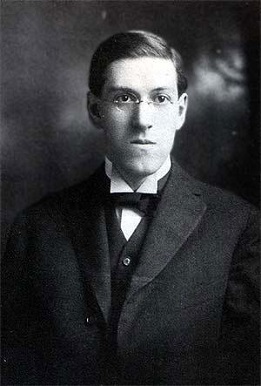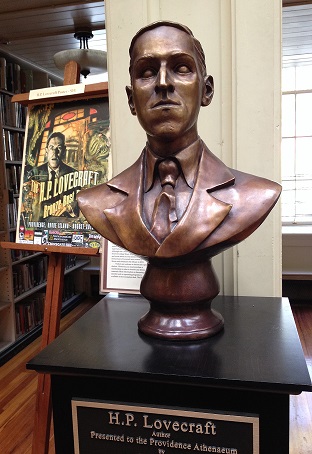H.P. Lovecraft's Friends, Neighbors, and Other Connections
There are several people buried at the North Burial Ground who were childhood acquaintances, friends, or neighbors of H.P. Lovecraft, or who had other close connections to him. Click on a link to read more about each of these individuals.

Clara L. Hess (1890-1950) was a childhood neighbor of Lovecraft, and continued to be a neighbor for several decades.
Clara wrote the following in the September 19, 1948 edition of the Providence Journal:
Howard Lovecraft and I grew up in the same “old time” East Side neighborhood in Providence. . . . Although of a younger generation, I knew Howard’s mother better than I knew Howard, who even as a young boy was strange and rather a recluse. . . . Mrs. Lovecraft talked continuously of her unfortunate son, who was so hideous that he hid from everyone and did not like to walk upon the streets where people could gaze at him.
When I protested that she was exaggerating and that he should not feel that way, she looked at me with a rather pitiful look as though I did not understand. . . .
Howard used to go out into the fields in back of my home to study the stars. One early fall evening, several of the children in the vicinity assembled to watch him from a distance. Feeling sorry for his loneliness, I went up to him and asked him about his telescope and was permitted to look through it. But his language was so technical that I could not understand it, and I returned to my group and left him to his lonely study of the heavens.
Chester Pierce Monroe (1889-1943), along with his brother Harold, was another childhood friend of Lovecraft’s. According to Lovecraft’s biographer, S.T. Joshi, 1902 was the year in which “he developed two of his earliest but strongest friendships—with Chester and Harold Munroe, who lived about four blocks away from him.”
In a 1915 essay, Lovecraft writes:
Visitors at the Slater Avenue Primary and Grammar School in Providence, examining the desks and walls of the building, or the fence and the long bench in the boys’ yard, may today discern among the multitude of names unlawfully carved by generations of youthful irrepressibles frequent repetitions of the initials “C.P.M. & H.P.L.,” which the vicissitudes of sixteen years have failed completely to efface. The two friends whose initials are thus early associated have not been separate in spirit during the ensuing years.
As a young man, Lovecraft produced journals and magazines, including The Rhode Island Journal of Astronomy and The Scientific Gazette and he was imitated in this regard by Munroe. Joshi writes that “The Rhode Island Journal of Astronomy for April 30, 1905 announces the establishment of the East Side News, C.P. Munroe, Editor. . . This magazine [was] described by Lovecraft in the issue of May 21, 1905 as a ‘very superior sort of paper… which, besides local news contains much of general interest.’”
Lovecraft and Munroe were also principles in two other childhood businesses that year, The Providence Detective Agency and the Blackstone Orchestra (“Fine music cheap”).
A few years later, Chester and his father Addison P. Munroe (1862-1955) witnessed Lovecraft’s August 12, 1912 will.
In an interview, Addison Munroe described the friendship of the two young men:
He lived but a few houses distant from our own home and was quite frequently over here with our sons. I remember that we had a room fixed up in our basement for the boys to use as a club room, which was a popular place with Howard. The club, so called, consisted of about a half-dozen of the neighborhood boys, around twenty years of age, and when they had a so-called “banquet,” improvised and usually self-cooked, Howard was always the speaker of the evening and my boys always said he delivered addresses that were gems. . . . Occasionally I would have an opportunity to talk with him and he always surprised me with the maturity and logic of his talk. I remember one time in particular, when I was a member of the R.I. Senate, 1911-1914, we had several important measures before that body; Howard, being over here one evening, started to discuss some of these measures. . . . he knew more about them than 75 percent of the Senators who would finally vote on them.

the Providence Anthenaeum.
Chester Munroe took a job in Asheville, NC in 1913, and seems to have brokered a writing opportunity for Lovecraft with the Asheville Gazette-News, where the latter published 14 astronomy articles between February and May 1915.
Another neighbor of Lovecraft’s (though not of his own age like Clara and Chester) was James Tobey Pyke (1858-1935). In 1904, HP and his mother moved to 598 Angell Street after the death of his grandfather. Pyke, whose own father died the same year, lived with his widowed mother, Eleanor Fish Pyke (1834-1912), next door (around the corner on the same lot) at 237 Butler Avenue. James Pyke was over 30 years older than Lovecraft, but they must have had a lot in common. Both were sickly, and writers, and lived with their widowed mothers. In 1914, Lovecraft wrote a poem “To The Rev. James Pyke on His Unpublished Verse,” which appeared in Volume 1, Number 1 of the United Official Quarterly. In it he writes:
Of one who sits enrapture’d by your lays.
Scorn not applause from him you taught to know
The lyric strain, the true poetic glow.
The poem is quoted in an essay by Randy Everts; Everts says that Donald Clarke claimed that Pyke was a family friend and advised Lovecraft on his poetry when he was a teenager. These lines seem to bear out that claim.
Lovecraft also penned a brief essay entitled “Introducing Mr. James Pyke” in his self-published journal, The Conservative, in 1916. In it he lauds Pyke’s poetic skills, and he concludes:
It is not often that an organization of amateurs can boast the membership of a genius of Mr. Pyke’s type and “The Conservative” has scant need to say that he is vastly proud to have been the means of bringing Mr. Pyke into his beloved United Amateur Press Association.
During the last four years of his life, Lovecraft lived in a house at 66 College Street in Providence that was originally built by Samuel Brenton Mumford (1791-1849), a commercial merchant. He also used this home as the residence of Robert Blake in his 1935 short story, “The Haunter of the Dark.” (The house has since been moved to 65 Prospect Street.)
The final significant Lovecraft connection to the NBG is that of Cyrus Butler (1767-1849). Lovecraft’s biographer Joshi begins to explain the connection:
At the northern end of Blackstone Boulevard is found Butler Hospital for the Insane, opened in 1847 from a grant supplied by Nicholas Brown . . . and Cyrus Butler, for whom it came to be named.
Both of Lovecraft’s parents would die at this hospital. His father, Winfield Scott Lovecraft, was committed there from April 1893 until his death in July 1898. And in March, 1919, his mother, Sarah Susan Phillips Lovecraft, was admitted to Butler, where she would remain until her death in 1921.
Further Reading
Cannon, Peter, ed. Lovecraft Remembered. Sauk City, Wisconsin: Arkham House Publishers, 1998.
Joshi, S.T. H.P. Lovecraft: A Life. West Warwick, RI: Necronomicon Press, 1996.
Lovecraft, Howard P. “Introducing Mr. Chester Pierce Munroe.” The Conservative, April 1915.
Lovecraft, Howard P. “Introducing Mr. James Pyke.” The Conservative, January 1916.
